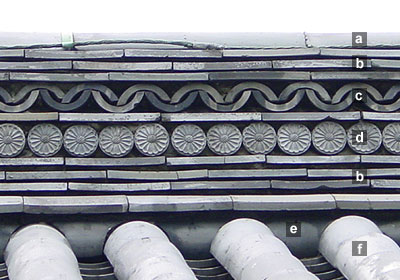|
||
 |
||

a) *ganburigawara 雁振瓦 b) *noshigawara 熨斗瓦 c) *wachigaigawara 輪違瓦
d) kikugawara 菊瓦 e) *kanimendo gawara 蟹面戸瓦 f) *marugawara 丸瓦
Edojou Shimizumon 江戸城清水門 (Tokyo)
d) kikugawara 菊瓦 e) *kanimendo gawara 蟹面戸瓦 f) *marugawara 丸瓦
Edojou Shimizumon 江戸城清水門 (Tokyo)
(C)2001 Japanese Architecture and Art Net Users System. No reproduction or republication without written permission.
掲載のテキスト・写真・イラストなど、全てのコンテンツの無断複製・転載を禁じます。

